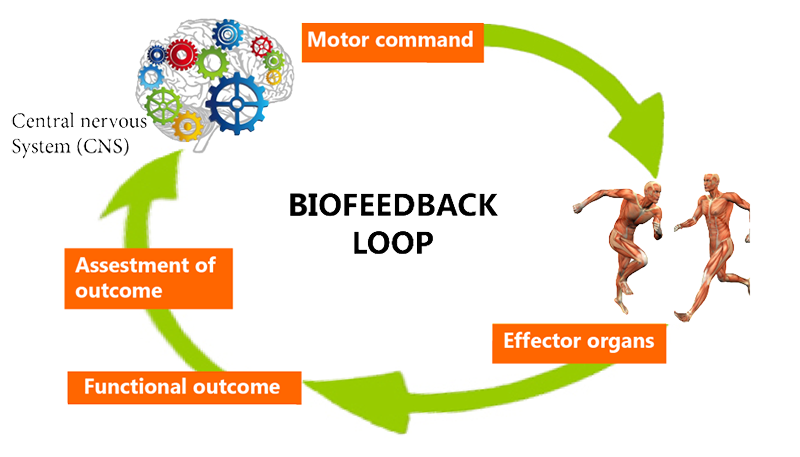Overview
Biofeedback is a technique you can use to learn to control your body's functions, such as your heart rate. With biofeedback, you're connected to electrical sensors that help you receive information (feedback) about your body (bio).
This feedback helps you focus on making subtle changes in your body, such as relaxing certain muscles, to achieve the results you want, such as reducing pain. In essence, biofeedback gives you the power to use your thoughts to control your body, often to improve a health condition or physical performance.

Types of biofeedback
Your therapist might use several different biofeedback methods. Determining the method that's right for you depends on your health problems and goals. Biofeedback methods include:
- Brainwave. This type of method uses scalp sensors to monitor your brain waves using an electroencephalograph (EEG).
- Breathing. During respiratory biofeedback, bands are placed around your abdomen and chest to monitor your breathing pattern and respiration rate.
- Heart rate. This type of biofeedback uses finger or earlobe sensors with a device called a photoplethysmograph or sensors placed on your chest, lower torso or wrists using an electrocardiograph (ECG) to measure your heart rate and heart rate variability.
- Muscle. This method of biofeedback involves placing sensors over your skeletal muscles with an electromyography (EMG) to monitor the electrical activity that causes muscle contraction.
- Sweat glands. Sensors attached around your fingers or on your palm or wrist with an electrodermograph (EDG) measure the activity of your sweat glands and the amount of perspiration on your skin, alerting you to anxiety.
- Temperature. Sensors attached to your fingers or feet measure your blood flow to your skin. Because your temperature often drops when you're under stress, a low reading can prompt you to begin relaxation techniques.
Biofeedback Devices
You can receive biofeedback training in physical therapy clinics, medical centers and hospitals. A growing number of biofeedback devices and programs are also being marketed for home use, including:
- Interactive computer or mobile device programs. Some types of biofeedback devices measure physiological changes in your body, such as your heart rate activity and skin changes, by using one or more sensors attached to your fingers or your ear. The sensors plug into your computer.
Using computer graphics and prompts, the devices then help you master stress by pacing your breathing, relaxing your muscles and thinking positive thoughts. Studies show that these types of devices might be effective in improving responses during moments of stress, and inducing feelings of calm and well-being.
Another type of biofeedback therapy involves wearing a headband that monitors your brain activity while you meditate. It uses sounds to let you know when your mind is calm and when it's active to help you learn how to control your stress response. The information from each session can then be stored to your computer or mobile device.
- Wearable devices. One type of wearable device involves wearing a sensor on your waist that monitors your breathing and tracks your breathing patterns using a downloadable app. The app can alert you if you're experiencing prolonged tension, and it offers guided breathing activities to help restore your calm.
The Food and Drug Administration has approved a biofeedback device, Resperate, for reducing stress and lowering blood pressure. Resperate is a portable electronic device that promotes slow, deep breathing.
However, many biofeedback devices marketed for home use aren't regulated by the Food and Drug Administration. Before trying biofeedback therapy at home, discuss the different types of devices with your doctor to find the best fit.
Be aware that some products might be falsely marketed as biofeedback devices, and that not all biofeedback practitioners are reputable. If a manufacturer or biofeedback practitioner claims that a biofeedback device can assess your organs for disease, find impurities in your blood, cure your condition or send signals into your body, check with your doctor before using it, as it might not be legitimate.
Why it's done
Biofeedback, sometimes called biofeedback training, is used to help manage many physical and mental health issues, including:
- Anxiety or stress
- Asthma
- Attention deficit hyperactivity disorder (ADHD)
- Chemotherapy side effects
- Chronic pain
- Constipation
- Fecal incontinence
- Fibromyalgia
- Headache
- High blood pressure
- Irritable bowel syndrome
- Motion sickness
- Raynaud's disease
- Ringing in the ears (tinnitus)
- Stroke
- Temporomandibular joint disorder (TMJ)
- Urinary incontinence
Biofeedback appeals to people for a variety of reasons:
- It's noninvasive.
- It might reduce or eliminate the need for medications.
- It might be a treatment alternative for those who can't tolerate medications
- It might be an option when medications haven't worked well.
- It might be an alternative to medications for some conditions during pregnancy.
- It helps people take charge of their health.